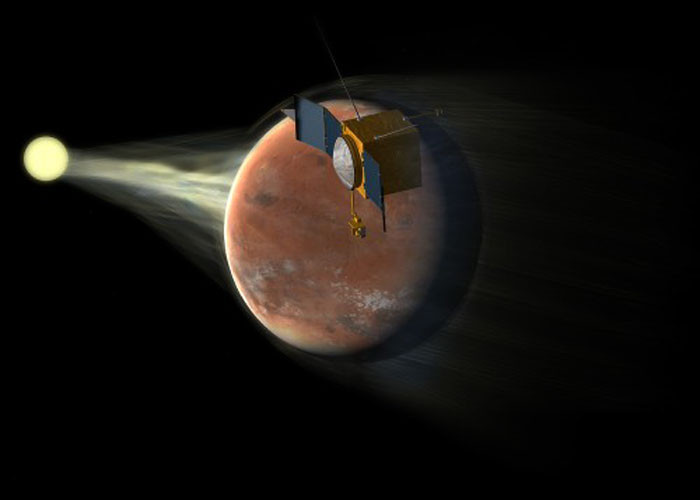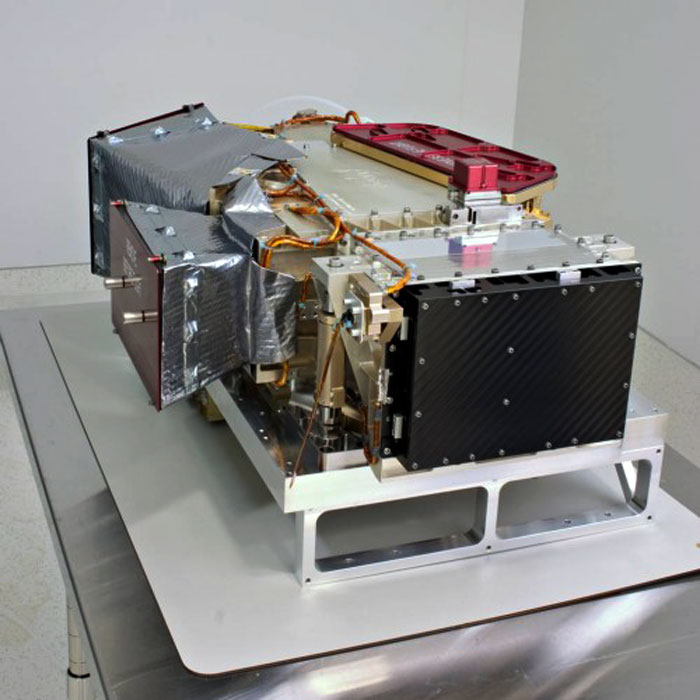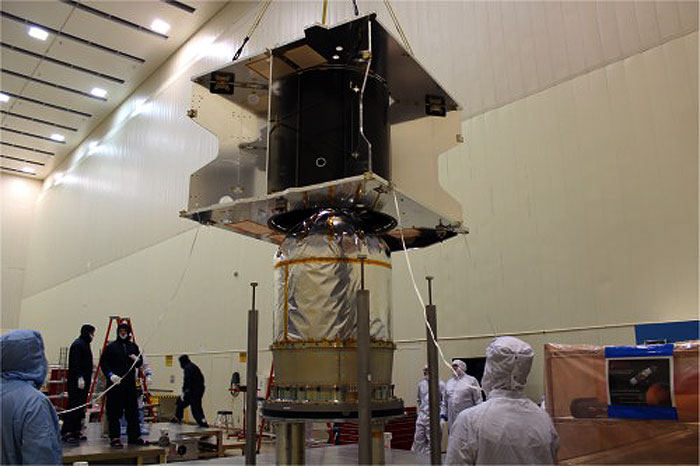-

The Mars Atmosphere and Volatile EvolutioN (MAVEN) mission is part of NASA’s Mars Scout program. Set to launch in 2013, the mission will explore the Red Planet’s upper atmosphere and its interactions with the sun and solar wind, giving insight into the history of Mars’ atmosphere and climate, liquid water, and planetary habitability. Image Credit: Corby Waste/NASA JPL
-
In one year, on November 18, 2013, the launch window will open for NASA’s next ambitious science mission to Mars, one that will – for the first time – be entirely devoted to studying the red planet’s thin upper atmosphere and answer questions about how and why the planet’s atmosphere has almost completely disappeared. NASA’s Mars Atmosphere And Volatile EvolutioN (MAVEN) mission will help scientists put together the puzzle that addresses exactly when conditions on the red planet were favorable for liquid water, as well as the potential for life, and this past week the spacecraft came one step closer to being ready for its mission.
A remote sensing instrument package was delivered to Lockheed Martin’s Waterton Canyon facility in Littleton, CO for integration into the MAVEN spacecraft last week. The instrument will peer into the ultraviolet to help answer questions about how Mars lost its atmosphere, which has left the red planet a dry, unforgiving, barren wasteland. The hardware consists of an Imaging UltraViolet Spectrograph (IUVS) and its control electronics box, the Remote Sensing Data Processing Unit (RSDPU).
The hardware was conceived, designed and built by the University of Colorado’s Laboratory for Atmospheric and Space Physics (CU/LASP) at Boulder, under contract to NASA’s Goddard Space Flight Center in Greenbelt, MD.

The Remote Sensing package aboard the MAVEN spacecraft, was conceived, designed and built by the University of Colorado’s Laboratory for Atmospheric and Space Physics (CU/LASP) at Boulder. This remote sensing instrument will peer into the ultraviolet to offer clues to how Mars might have lost its atmosphere. Credit: Aref Nammari/CU/LASP
-
“The Remote Sensing package team built a system that meets all technical requirements and delivered it on schedule and on budget,” said David Mitchell, MAVEN project manager from NASA’s Goddard Space Flight Center. “I look forward to the instrument’s next level of integration onto the spacecraft and ultimately the science it will provide.”
The IUVS is the eyes of the instrument and the biggest on the spacecraft, collecting the light and spreading it out into spectra and recording the spectra using imaging detectors. The RSDPU is the brain of the instrument, which will receive and execute the commands sent to tell IUVS when and where to look. It is the main electronics box that controls IUVS and communicates with the spacecraft. The instrument package will be installed on the MAVEN spacecraft this week.
“The IUVS performs ‘remote sensing,’ meaning we can study the planet and its atmosphere at a distance through the light it emits,” said Nick Schneider, IUVS lead scientist from CU/LASP. “Ultraviolet light is especially diagnostic of the state of the atmosphere, so our instrument provides the global context of the whole atmosphere for the local measurements made by the rest of the payload.”
MAVEN will have a 20-day window of opportunity to launch next November. If the launch vehicle, a United Launch Alliance Atlas-V 401 rocket, cannot get off the ground during those 20 days then the MAVEN team will have to wait until 2016 before Mars and the Earth are favorably aligned for launch again.
The $670 million mission, if launched on time November 18, 2013, would arrive at Mars on September 22, 2014. Upon its arrival, MAVEN will go into an orbit around the red planet, circling at an altitude ranging anywhere from 100 – 4,000 miles. A total of eight science instruments will help MAVEN study Mars’ upper atmosphere and ionosphere, determining how the loss of nitrogen, hydrogen, and carbon dioxide from the atmosphere has impacted the planet over time. The research, in a combined effort with vehicles already on the ground and in orbit above Mars, will help scientists determine when water – and the potential conditions favorable for life – may have been present on the red planet.
“They can take that information and make computer models,” said Guy Beutelschies, program manager for the mission at Lockheed Martin. ”They can then use those models to basically go back in time and see when in the history of Mars conditions would have been right to have oceans, lakes and rivers on the surface. If we can show in these computer models that Mars once had liquid water and that it was warm enough, then you’ve got all the conditions for life potentially to have evolved.”

The MAVEN spacecraft core structure is successfully lowered and mated to the hydrazine propulsion tank and boat tail assembly at Lockheed Martin, Denver, Colorado. Photo Credit: Lockheed Martin
-
The mission will be managed by NASA’s Goddard Space Flight Center, who will provide mission systems engineering, mission design, and safety and mission assurance. Lockheed Martin developed the spacecraft, and will conduct assembly, test and launch operations, and provide mission operations at their Waterton Canyon facility in Littleton, CO. NASA’s Jet Propulsion Laboratory (JPL) will provide navigation and communication support through the Deep Space Network facilities in California, Spain, and Australia.
The University of Colorado has built two of MAVEN’s science instruments, and will coordinate the science team, science operations, and lead Education/Public Outreach. Even though UC/LASP is contributing only two of MAVEN’s eight instruments, they will be in charge of sending commands to all of them. Their second instrument contribution to MAVEN, the Langmuir Probe and Waves instrument, will determine ionospheric properties, wave heating in the atmosphere and solar extreme-ultraviolet input to the atmosphere. The other instruments will be provided by The University of California-Berkeley Space Sciences Laboratory and NASA’s Goddard Space Flight Center.
Having passed a critical Mission Operations Review last week, the MAVEN team is on budget and on schedule, and hopes to deliver their spacecraft on a Boeing C-17 to Cape Canaveral Air Force Station next August. ”I’m incredibly proud of how this team continues to meet every major milestone on schedule on its journey to Mars,” said Mitchell. ”Being ready for the start of system level integration and test is critically important to ultimately being ready for launch on November 18, 2013.”
-
Quelle: NASA
5998 Views
